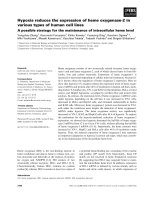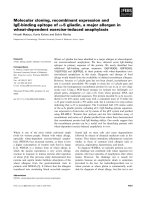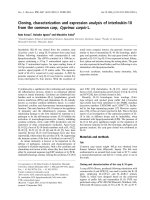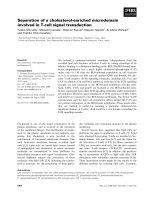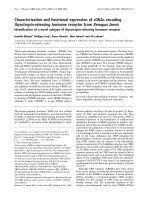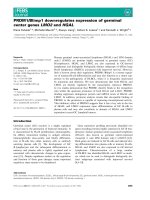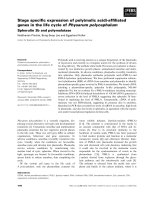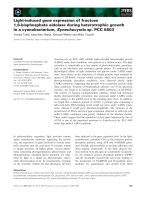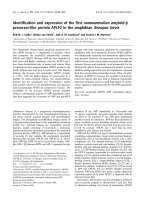báo cáo khoa học: "Absent Toll-like receptor-9 expression predicts poor prognosis in renal cell carcinoma" pps
Bạn đang xem bản rút gọn của tài liệu. Xem và tải ngay bản đầy đủ của tài liệu tại đây (898.26 KB, 6 trang )
RESEARCH Open Access
Absent Toll-like receptor-9 expression predicts
poor prognosis in renal cell carcinoma
Hanna Ronkainen
1*†
, Pasi Hirvikoski
2†
, Saila Kauppila
3
, Katri S Vuopala
4
, Timo K Paavonen
5
, Katri S Selander
6,7
and
Markku H Vaarala
1,3
Abstract
Background: Toll-like receptor 9 (TLR9) is a cellular DNA-receptor whose activation with cognate ligands triggers
an immu ne reaction, with increased production of inflammatory cytokines. The aim of this study was to examine
the expre ssion of TLR9 in renal cell carcinoma (RCC), which is genera lly renowned of its immunogenic nature. We
also evaluated the prognostic value of TLR9 in RCC.
Methods: TLR9 expression in RCC was characterized with immunohistochemistry in a retrospective study
population of 152 RCC patients who underwent renal surgery. The TLR9 staining intensity was compared with
clinical parameters.
Results: Of the studied tumours, 112 (81%) exhibited cytoplasmic TLR9 immunostaining. No association was
detected between cytoplasmic TLR9 immunoexpression intensity and stage, nuclear grade, histological subtype or
tumour necrosis. Cytoplasmic TLR9 immunoexpression was, however, a mar ker of favourable RCC specific survival
both in univariate analysis and in multivariate regressi on model.
Conclusions: We conclude that TLR9 expression is an independent prognostic marker of RCC and the absence of
TLR9 expression is related to poorer prognosis in RCC.
Keywords: renal cell carcinoma, toll-like receptor 9, tumour necrosis, prognosis
Background
Renal cell carcinoma (RCC) is a cancer of increasing inci-
dence and mortality [1]. At the time of the diagnosis, up
to one third of the patients have metastasized disease and
a half of the remaining patients will experience a recur-
rence af ter an initially curative treatment [2]. Despite the
many well-known prognostic factors for the disease, the
behaviour of RCC is very difficult to predict.
Toll-like receptors (TLRs) are pattern recognition
receptors that detect both microbe- and host-derived
molecular patterns. Thus far, at least 13 mammalian
TLRs have been recognized, each of them responding to
a different ligand. The subcellular expression sites of t he
various TLRs also vary. TLRs 1, 2 and 4 are expressed
and bind their ligands on th e cell surface while the TLR9
subfamily (including TLRs 3, 7, 9 and 13) reside in intra-
cellular vesicles. Ligand binding to TLRs activates tran-
scription factors, such a s NF-kappaB a nd the eve ntual
outcome of TLR activation is an immune reaction, char-
acterized by increased production of inflammatory med-
iators. Specifically, TLR9 is a receptor for both microbial
and vertebrate DNA. The intracellular expression of
TLR9 and also possibly the other endosomal TLRs is
thought to evade self-recognition of DNA and RNA [3-7].
It is now well established that TLR9 is also expressed in
various cancer cells, including breast, brain, ovarian, gas-
tric, lung and prostate cancer cells [8-11]. Furthermore,
in clinical bre ast, ovarian an d prostate canc er specimens,
increased TLR9 expression was associated with decreased
tumour differentiation [10-13]. It has also been demon-
strated that stimulation of TLR9-expressin g cancer cells
with synthetic TL R9-ligands incre ases thei r in vitro inva-
sion which is associated with the down-regulati on of tis-
sue inhibitor of metalloproteinases-3 (TIMP3) and the
up-regulation of matrix metalloproteinase-13 (MMP-13)
* Correspondence:
† Contributed equally
1
Department of Surgery, Oulu University Hospital, PO Box 21, 90029 OYS,
Finland
Full list of author information is available at the end of the article
Ronkainen et al. Journal of Experimental & Clinical Cancer Research 2011, 30:84
/>© 201 1 Ronkainen et al; licensee BioMed Central Ltd. This is an Open Acce ss article distributed under the terms of the Creative
Commons Attribution Lice nse ( whi ch permits unrestricted use, distribution, and
reproduction in any medium, provided the original work is properly cited.
activity. Although bacterial DNA, similar to the synthetic
CpG-sequence containing TLR9-ligands, also induces
invasion in TLR9 expressing cancer cells in vitro, the nat-
ural TLR9-ligand that might induce invasion for example
in breast cancers, remains unknown [10,11].
In the normal kidney, TLR9 expression has been
detected in the renal tubules and interstitial tissue, while
the tubulointerstitial and glomerular expression has
been detected in lupus nephritis [14]. Previously, TLR9
has been associated with renal disease, such as glomeru-
lonephritis [15] and lupus nephritis [16]. To our knowl-
edge, there are no previous studies of TLR9 expression
in RCC. However, the efficacy of a synthetic TLR9-ago-
nist has been studie d in a clinical trial in advanced
metastatic RCC. This compound was found to have only
modest antitumour activity [17].
The aim of this study was to investigate TLR9 expres-
sion in RCCs and to evaluate the prognostic significance
of TLR9 immunostaining in RCCs.
Material and methods
Patients
This retrospective clinical cohort consisted of 152
patients with 77 (51%) females and 75 (49%) males who
underwent surgery for primary renal cell carcinoma
between th e years 1990 and 1999, at the Oulu University
Hospital. All clinical data and patient follow-up details
were collected from patient records and re-evaluated by
the same urologist (HR). Seven patients (5%) were oper-
ated by resection and 145 (95%) by radical nephrectomy.
Atthetimeofthediagnosis,themedianageofthe
patients w as 63 years old (range 29-86 years) and the
mean age was 62 (SD ± 11 years). The median and mean
follow-up times were 90 (range 0-209) months and 90
(SD ± 63) months, respectively. Complete infor mation
was obtained from all patients. During the follow-up per-
iod, 44 (29%) patients died of RCC, 40 (26%) died of
other causes and 68 (45%) were still alive. The distribu-
tion of the clinicopathological paramete rs of the tumours
has been previously described [18,19]. Of the patients,
6 (4%) had lymph node metastases and 18 (12%) had dis-
tant metastases. The stage of the tumours was assigned
using the TNM staging of RCC [20]. T and N classes
were determined by the pathological evaluation of pri-
mary tumour and resected lymph nodes. Furth er, N class
and M class were assessed by radiologi cal evaluation per-
formed before primary operation. The abdominal ultra-
sound was done for every patient and in addition,
abdominal co mputed t omograph y (CT) was perfor med
for 125 patients (82%). Chest radiography (X-ray and/or
CT) was done for 135 pa tients (89%). In a case of sus-
pected metastases or vena caval involvement, addi tional
studies such as bone scintigraphy (14 patients, 9%), skele-
tal radiography (17 patients, 11%), magnetic r esonance
imaging (MRI) (11 patients, 7%) or cavography (3
patients, 2%) were perfor med. The s tudy was approved
by the local ethical board.
Tumour samples and TLR9 immunostaining
The tumour samples were routinely fixed in 10% buffered
formalin and embedded in paraffin. The histological diag-
nosis was confirmed by reviewing the haematoxylin and
eosin (H & E) stained original sections simultaneously by
two pathologists. The tumours were re-classified and
graded according to the WHO classific ation [21]. The
most representative block of the tumour wa s selected
and cut into 3 μm thick section s, into multi-tissue blocks
which were mounted onto pre coated slides. Tissue sec-
tions were then deparaffinized in xylene, re hydrated in
descending ethanol series and washed in phosphate buf-
fered saline (PBS). Expression of TLR9 was analyzed by
using a mouse monoclonal anti-human TLR9/CD289
(Img-305A, clone 26C593.2, Imgenex, San Diego, Califor-
nia, USA, dilution 1:200) antibody, as previously shown
by us [13,22]. In order to enhance the immunoreactivity,
the sections were incubated in a Tris-EDTA buffer (pH
9.0) and boiled. Endogenous peroxidase activity was
eliminated by incubation in hydrogen peroxide and abso-
lute methanol. The bound antibodies were visualiz ed
using Envision Det ection System (K500711; Dako De n-
mark A/S). DAB (diaminobenzi dine) was used as a chro-
mogen. A multitissue block containing b reast cancer
samples and normal cervical tissue was used as a positive
control.
Scoring of TLR9 immunoreactivity
Cytoplasmic TLR9 immunoreactivity was initially scored
according to four cytoplasmic staining intensities: nega-
tive (0), weak (1), moderate (2) or strong (3) [13,22]. For
further statistical analyses, the negative samples (score 0)
were compared with the positive ones (scores 1 to 3).
Immunohistochemical staining was evaluated simulta-
neouslybytwoobservers(PHandMHV)whowere
blind ed to the clinical data and a consensus on the stain-
ing intensity was reached.
Statistical analyses
The software SPSS for Windows 15 ( Chicago, IL) was
used for statistical analyses. Associations between factors,
including clinicopathological variables and TLR9 immu-
nostaining patterns, were assessed by the c2test,orthe
Fisher’s exact test in the case of low expected frequencies.
Survival rates were ca lculated using the Kaplan-Meier
method and the statistical significance between groups
was analysed using the log-rank test. Hazard ratio (HR)
was assessed by Cox univariate analysis. Renal cel l carci-
noma-specific survival was cal culated fr om the date of
diagnosis to death from RCC or the last day of follow-up.
Ronkainen et al. Journal of Experimental & Clinical Cancer Research 2011, 30:84
/>Page 2 of 6
Deaths due to intercurrent causes were censored. Multi-
variate survival analysis was done with the Cox propor-
tional hazards mod el; the following covariates were
entered: gender, a ge, stage, Fuhrman grade and TLR9
immunoreactivity. All p-values were two sided.
Results
TLR9 protein expression in RCC
There were 138 RCC tumours available for the evaluation
of TLR9 immu noreactivity. Examples of TLR9 staining
patterns are shown in Figure 1. Twenty-one (15%) of the
tumours were strongly positive, 39 (28%) moderately
positive, 52 (38%) weakly positive and 26 (19%) negative
for cytoplasmic TLR9 immunostaining. For the further
analyses, the weakly, moderately and strongly positive
cases were combined and grouped as TLR9 positive sam-
ples (n = 112, 81%). Some nuclear TLR9 immuno positiv-
ity was also detected in 60 (44%) tumour samples. In
addition to immunoexpression of TLR9 in the tumour
cells, immunoreactivity was observed in endothelial and
inflammatory cells as well as in some fibroblasts.
Association of cytoplasmic TLR9 expression with the
clinicopathological characteristics
The distributions of pT-class, stage, nuclear grade and his-
tological subtype of RCC and their associations with cyto-
plasmicTLR9expressionarepresentedinTable1.No
statistically significant associations were detected between
cytoplasmic TLR9 expression and pT-class, stage or grade.
The immunoexpression of TLR9 did not associate with
tumour necrosis (data not shown). There was no associa-
tion between TLR9 expression and histological subtype.
The immunoexpression of TLR9 was common in every
histological subtype of RCC and immunopositivity for
TLR9 was detected in 100 (82%), 6 (67%), 4 (80%) a nd 2
(100%) cases tumours representing the histological sub-
types of clear cell RCC, papillary RCC, chromophobe RCC
and unclassified RCC, respectively. Nuclear TLR9 expres-
sion did not have any association with these characteristics
(data not shown).
Prognostic significance of TLR9 expression in RCC
The RCC-specific survival was significantly longer for
patients whose tumours did express cytoplasmic TLR9, as
compared with patients whose tumours were negative for
cytoplasmic TLR9 expression (p = 0.007) (Figure 2.). The
hazard ratio (HR) of patients without TLR9-expressing
tumours was 2.40 (95% CI 1.24-4.63, p = 0.009). The
mean RCC-specific survival times for TLR9 negative and
TLR9 positive tumours were 112 (95% CI 76-147) and 160
(95% CI 144-175) months, respectively (p = 0.007)
In the Cox regression analysis for cytoplasmic TLR9
expression, gender, age, stage and nuclear grade, the sta-
tistically significant factors in RCC-specific survival were
stage and TLR9 expression (Table 2).
Discussion
We demonstrate here for the first time that TLR9 is fre-
que ntly expre ssed in RCCs. Although there was no asso-
ciation between the immunoexpression of TLR9 and
histological subtype, stage or grade of RCC, cytoplasmic
TLR9 expression was a statistically significant prog nostic
factor in RCC specific survival in both univariate and
multivariate analyses and TLR9 expression was an inde-
pendent marker of better prognosis in RCC. Our findings
Figure 1 TLR9 immunostaining in RCC. Tumours with hi gh
cytoplasmic expression (A) and negative cytoplasmic expression (B)
are shown. Magnification ×400, scale bar 50 μm.
Table 1 Associations between cytoplasmic TLR9
expression and tumour pT-class, stage, grade and
histological subtype
Cytoplasmic TLR9 expression
negative positive p-value
pT class
pT1 12 (18%) 56 (82%) 0.31
pT2 4 (36%) 7 (64%)
pT3 8 (15%) 45 (85%)
pT4 2 (33%) 4 (67%)
Stage
I 11 (17%) 52 (83%) 0.27
II 4 (36%) 7 (64%)
III 6 (13%) 39 (87%)
IV 5 (26%) 14 (74%)
Nuclear Grade
I 0 (0%) 5 (100%) 0.69
II 13 (18%) 60 (82%)
III 9 (25%) 27 (75%)
IV 4 (18%) 18 (82%)
Histology
clear cell 22 (18%) 100 (82%) 0.69
papillary 3 (33%) 6 (67%)
chromophobic 1 (20%) 4 (80%)
undifferentiated 0 (0%) 2 (100%)
Ronkainen et al. Journal of Experimental & Clinical Cancer Research 2011, 30:84
/>Page 3 of 6
thus suggest that the lack of TLR9 confers aggressive
behaviour of renal carcinoma cells. The significance of
nuclear TLR9 expression remains obscure, but it may
also represent unspecific staining.
Expression of TLR9 has been previously detected in
various cancer cell lines and in various clinical cancer
specimens. Synthetic TLR9-ligands induce cancer cell
invasion in vitro and high TLR9 expression has been
associated with poor differentia tion of various cancers,
suggesting that high TLR9 expression or naturally exist-
ing DNA-ligands might induce TLR9-mediate d invasion,
and thus contribute to worse outcomes in cancers with
higher TLR9 expression. In this light, our finding demon-
strating the lack of TLR9 expression as a poor prognosis
marker is RCC is surprising. So far, the association
between T LR9 and clinopathological parameters and the
survival of cancer patient has been evaluated in only a
few studies. In breast cancer it has been demonstrated
that immunoexpression of TLR9 is significantly increased
in high-grade tumours compared with lower-grade
tumours [12,22]. Similarly, it has been s hown that recur-
rent breast carcinomas exhibit a sign ificant increase in
the mRNA levels of TLR9 in can cer cells [23]. However,
a remarkable percentage (57.5%) of recurrent breast
tumours was shown to express TLR9 by fibroblast-like
cells and these tumours have reported to have l ow prob-
ability of metastasis [23]. It has also been demonstrated
that cell surface stimulation of TLR9 promotes cell pro-
liferation and survival in hepatocellular carcinoma [24].
In neuroblastoma, TLR9 expression has been found to
correlate inversely with disease stage [25] whereas in
glioma, TLR9 expression has shown to be significantly
higher in high grade tumours compared to low-grade
gliomas and TLR9 i mmunoexpression has been reported
to be a statistically significant marker of poorer prognosis
in glioma [26]. Thus, the contribution of either high or
low TLR9 expression to the pathophysiology of cancer
may be highly tumour specific.
Upon the recognition of DNA, TLR9 recruits specific
intracellular adaptor proteins to initiate signalling path-
ways and the eventual outcome is an immune reaction
characterized by the increased production of inflamma-
tory mediators like inte rferon and other inflammatory
cytokines [3,27]. RCC is generally renowned of its immu-
nogenic nature. R CC can allure different effect or ce lls of
both the innate and adaptive immune system including
nat ural killer (NK) c ells, dendritic cell s (DC) and various
T cells [28]. A v ariety of tumour-assoc iated antigens
(TAAs) which can evoke tumour-specific T-cell-defined
immune responses in cancer patients has been detected
in RCC tumours [29]. More importantly, immunotherapy
with interferon alpha (IFN-a)orinterleukin2(IL-2)can
produce even complete and durable response in
advanced RCC [30] and tumour vaccines have shown to
have some response, too [31]. Rare cases of spontaneous
regression of metastases in RCC caused probably by
immunologic mechanism have been reported [3 2]. Thus,
the prognostic significance of TLR9 expression in RCC
may be associated with immune responses to the tumour
cells. Hypothetically, in the absence of RCC TLR9
expression, such responses are n ot evoked and they are
less susceptible to immunosurveillance and they can pro-
gress. These issues warrant further investigation.
Low oxygen environments can be created by various
pathophysiological conditions, including infection, inflam-
mation, tissue injury, and solid tumours [33]. H ypoxia i s
one of the significant features of solid tumours, including
kidney tumours. Hypoxia and the compensatory hyperacti-
vation of angiogenesis are thou ght to be particularly impor-
tant in RCC [34]. In hypoxia, an increased expression of
variousTLRsincludingTLR9hasbeendemonstrated
Figure 2 Associations between cytoplasmic TLR9 expression
and RCC-specific survival. Patients with TLR9 negative tumours
showed reduced survival when compared to patients with tumours
positive for these proteins. p = 0.007
Table 2 Cox multivariate survival analysis in 136 patients
with RCC
Covariate Hazard ratio 95.0% CI p-value
Male gender 0.76 0.45-1.80 0.76
Age 1.02 0.98-1.06 0.34
Stage I 1 (ref.)
Stage II 3.03 0.89-10.3 0.076
Stage III 3.17 1.20-8.35 0.020
Stage IV 19.3 6.86-54.5 < 0.001
Fuhrman grade I or II 1 (ref.)
Fuhrman grade III 1.13 0.49-2.57 0.78
Fuhrman grade IV 2.68 1.20-5.98 0.16
Positive cytoplasmic
TLR9 expression
0.28 0.14-0.58 0.001
Ronkainen et al. Journal of Experimental & Clinical Cancer Research 2011, 30:84
/>Page 4 of 6
[35,36] and this induction of TLRs has shown to be coordi-
nated by the hypoxia inducible factor 1 ( HIF-1) [35].
Whether or not the absence of TLR9 in RCC is regulated
by hypoxia and HIF-1 and thereby, increase the aggressive
behaviour of the tumour cells also warrant further
investigation.
Conclusions
In conclusion, TLR9 immunoexpression is common in
RCC, where it is associated with better prognosis in RCC
and the lack of TLR9 expression in RCC predicts short
survival. The favourable influence of TLR9 expression on
the course of the disease may be based on the immunolo-
gic response generated to the renal carcinoma cells. The
prognostic significance of TLR9 expression in RCC should
be evaluated in other RCC cohorts.
Acknowledgements
The authors wish to thank Ms Mirja Vahera, Ms Erja Tomperi, Ms Mirja
Mäkeläinen for their skilful technical assistance, and Pasi Ohtonen, M. Sc. for
his invaluable assistance with statistical analyses. This study was funded by
grants from the Finnish Cancer Foundation (HR), the Finnish Urological
Association (HR) and Päivikki and Sakari Sohlberg Foundation (TKP, MHV).
Author details
1
Department of Surgery, Oulu University Hospital, PO Box 21, 90029 OYS,
Finland.
2
Department of Pathology, Lansi Pohja Central Hospital, Kauppakatu
25, 94100 Kemi, Finland.
3
Department of Pathology, University of Oulu, PO
Box 50, 90014 University of Oulu, Finland.
4
Department of Pathology,
Lapland Central Hospital, PO Box 8041, 96101 Rovaniemi, Finland.
5
Department of Pathology, University of Tampere and Tampere University
Hospital, School of Medicine, 33014 University of Tampere, Finland.
6
Department of Medicine, Division of Hematology-Oncology, University of
Alabama at Birmingham, Birmingham, AL 35294-2182, USA.
7
Department of
Anatomy and Cell Biology, University of Oulu, PO Box 5000, 90014 University
of Oulu, Finland.
Authors’ contributions
HR performed statistical analyses and drafted the manucript. PH evaluated
the immunohistochemical staining. SK revised the manuscript. KSV carried
out immunohistochemical studies. TKP conceived of the study. KSS revised
the manuscript. MHV participated in the design of the study, evaluated the
immunohistochemical staining and revised the manuscript. All authors read
and approved the final manuscript.
Authors’ Information
Katri S Selander and Markku H Vaarala shared last authorship on this
manuscript.
Competing interests
The authors declare that they have no competing interests.
Received: 12 July 2011 Accepted: 19 September 2011
Published: 19 September 2011
References
1. Pantuck AJ, Zisman A, Belldegrun AS: The changing natural history of
renal cell carcinoma. J Urol 2001, 166(5):1611-1623.
2. Bui MH, Zisman A, Pantuck AJ, Han KR, Wieder J, Belldegrun AS: Prognostic
factors and molecular markers for renal cell carcinoma. Expert Rev
Anticancer Ther 2001, 1(4):565-575.
3. Akira S, Hemmi H: Recognition of pathogen-associated molecular
patterns by TLR family. Immunol Lett 2003, 85(2):85-95.
4. Wagner H: The immunobiology of the TLR9 subfamily. Trends Immunol
2004, 25(7):381-386.
5. Nishiya T, DeFranco AL: Ligand-regulated chimeric receptor approach
reveals distinctive subcellular localization and signaling properties of the
Toll-like receptors. J Biol Chem 2004, 279(18):19008-19017.
6. Leifer CA, Kennedy MN, Mazzoni A, Lee C, Kruhlak MJ, Segal DM: TLR9 is
localized in the endoplasmic reticulum prior to stimulation. J Immunol
2004, 173(2):1179-1183.
7. Shi Z, Cai Z, Sanchez A, Zhang T, Wen S, Wang J, Yang J, Fu S, Zhang D: A
novel Toll-like receptor that recognizes vesicular stomatitis virus. J Biol
Chem 2011, 286(6):4517-4524.
8. Chang YJ, Wu MS, Lin JT, Chen CC: Helicobacter pylori-Induced invasion
and angiogenesis of gastric cells is mediated by cyclooxygenase-2
induction through TLR2/TLR9 and promoter regulation. J Immunol 2005,
175(12):8242-8252.
9. Droemann D, Albrecht D, Gerdes J, Ulmer AJ, Branscheid D, Vollmer E,
Dalhoff K, Zabel P, Goldmann T: Human lung cancer cells express
functionally active Toll-like receptor 9. Respir Res 2005, 6:1.
10. Merrell MA, Ilvesaro JM, Lehtonen N, Sorsa T, Gehrs B, Rosenthal E, Chen D,
Shackley B, Harris KW, Selander KS: Toll-like receptor 9 agonists promote
cellular invasion by increasing matrix metalloproteinase activity. Mol Cancer
Res 2006, 4(7):437-447.
11. Ilvesaro JM, Merrell MA, Swain TM, Davidson J, Zayzafoon M, Harris KW,
Selander KS: Toll like receptor-9 agonists stimulate prostate cancer
invasion in vitro. Prostate 2007, 67(7):774-781.
12. Berger R, Fiegl H, Goebel G, Obexer P, Ausserlechner M, Doppler W, Hauser-
Kronberger C, Reitsamer R, Egle D, Reimer D, Muller-Holzner E, Jones A,
Widschwendter M: Toll-like receptor 9 expression in breast and ovarian
cancer is associated with poorly differentiated tumors. Cancer Sci 2010,
101(4):1059-1066.
13. Vaisanen MR, Vaisanen T, Jukkola-Vuorinen A, Vuopala KS, Desmond R,
Selander KS, Vaarala MH: Expression of toll-like r eceptor-9 is
increased in poorly differentiated prostate tumors. Prostate 2010,
70(8):817-824.
14. Papadimitraki ED, Tzardi M, Bertsias G, Sotsiou E, Boumpas DT: Glomerular
expression
of
toll-like receptor-9 in lupus nephritis but not in normal
kidneys: implications for the amplification of the inflammatory response.
Lupus 2009, 18(9):831-835.
15. Summers SA, Steinmetz OM, Ooi JD, Gan PY, O’Sullivan KM, Visvanathan K,
Akira S, Kitching AR, Holdsworth SR: Toll-like receptor 9 enhances
nephritogenic immunity and glomerular leukocyte recruitment,
exacerbating experimental crescentic glomerulonephritis. Am J Pathol
2010, 177(5):2234-2244.
16. Summers SA, Hoi A, Steinmetz OM, O’Sullivan KM, Ooi JD, Odobasic D,
Akira S, Kitching AR, Holdsworth SR: TLR9 and TLR4 are required for the
development of autoimmunity and lupus nephritis in pristane
nephropathy. J Autoimmun 2010, 35(4):291-298.
17. Thompson JA, Kuzel T, Drucker BJ, Urba WJ, Bukowski RM: Safety and
efficacy of PF-3512676 for the treatment of stage IV renal cell
carcinoma: an open-label, multicenter phase I/II study. Clin Genitourin
Cancer 2009, 7(3):E58-65.
18. Ronkainen H, Vaarala MH, Kauppila S, Soini Y, Paavonen TK, Rask J,
Hirvikoski P: Increased BTB-Kelch type substrate adaptor protein
immunoreactivity associates with advanced stage and poor
differentiation in renal cell carcinoma. Oncol Rep 2009, 21(6):1519-1523.
19. Ronkainen H, Hirvikoski P, Kauppila S, Vaarala MH: Anillin expression is a
marker of favourable prognosis in patients with renal cell carcinoma.
Oncol Rep 2011, 25(1):129-133.
20. UICC: TNM Classification of Malignant Tumours. 6. Wiley & Sons, New
York; 2002.
21. IARC: Tumours of the Urinary System and Male Genital Organs. IARC
Press, Lyon; 2004.
22. Jukkola-Vuorinen A, Rahko E, Vuopala KS, Desmond R, Lehenkari PP,
Harris KW, Selander KS: Toll-like receptor-9 expression is inversely
correlated with estrogen receptor status in breast cancer. J Innate Immun
2008, 1(1):59-68.
23. Gonzalez-Reyes S, Marin L, Gonzalez L, Gonzalez LO, del Casar JM,
Lamelas ML, Gonzalez-Quintana JM, Vizoso FJ: Study of TLR3, TLR4 and
TLR9 in breast carcinomas and their association with metastasis. BMC
Cancer 2010, 10:665.
24. Tanaka J, Sugimoto K, Shiraki K, Tameda M, Kusagawa S, Nojiri K, Beppu T,
Yoneda K, Yamamoto N, Uchida K, Kojima T, Takei Y: Functional cell
surface expression of toll-like receptor 9 promotes cell proliferation and
Ronkainen et al. Journal of Experimental & Clinical Cancer Research 2011, 30:84
/>Page 5 of 6
survival in human hepatocellular carcinomas. Int J Oncol 2010,
37(4):805-814.
25. Brignole C, Marimpietri D, Di Paolo D, Perri P, Morandi F, Pastorino F,
Zorzoli A, Pagnan G, Loi M, Caffa I, Erminio G, Haupt R, Gambini C, Pistoia V,
Ponzoni M: Therapeutic targeting of TLR9 inhibits cell growth and
induces apoptosis in neuroblastoma. Cancer Res 2010, 70(23):9816-9826.
26. Wang C, Cao S, Yan Y, Ying Q, Jiang T, Xu K, Wu A: TLR9 expression in
glioma tissues correlated to glioma progression and the prognosis of
GBM patients. BMC Cancer 2010, 10:415.
27. Kawai T, Akira S: Toll-like receptor and RIG-I-like receptor signaling. Ann N
Y Acad Sci 2008, 1143:1-20.
28. Geiger C, Nossner E, Frankenberger B, Falk CS, Pohla H, Schendel DJ:
Harnessing innate and adaptive immunity for adoptive cell therapy of
renal cell carcinoma. J Mol Med 2009, 87(6):595-612.
29. Neumann E, Engelsberg A, Decker J, Storkel S, Jaeger E, Huber C, Seliger B:
Heterogeneous expression of the tumor-associated antigens RAGE-1,
PRAME, and glycoprotein 75 in human renal cell carcinoma: candidates
for T-cell-based immunotherapies? Cancer Res 1998, 58(18):4090-4095.
30. Vogelzang NJ, Priest ER, Borden L: Spontaneous regression of
histologically proved pulmonary metastases from renal cell carcinoma: a
case with 5-year followup. J Urol 1992, 148(4):1247-1248.
31. Finley DS, Pantuck AJ, Belldegrun AS: Tumor biology and prognostic
factors in renal cell carcinoma. Oncologist 2011, 16(Suppl 2):4-13.
32. Lokich J: Spontaneous regression of metastatic renal cancer Case report
and literature review. Am J Clin Oncol 1997, 20(4):416-418.
33. Imtiyaz HZ, Simon MC: Hypoxia-inducible factors as essential regulators
of inflammation. Curr Top Microbiol Immunol 2010, 345:105-120.
34. Banumathy G, Cairns P: Signaling pathways in renal cell carcinoma.
Cancer Biol Ther 2010, 10(7):658-664.
35. Kuhlicke J, Frick JS, Morote-Garcia JC, Rosenberger P, Eltzschig HK: Hypoxia
inducible factor (HIF)-1 coordinates induction of Toll-like receptors TLR2
and TLR6 during hypoxia. PLoS One 2007, 2(12):e1364.
36. Liu Y, Zhu L, Fatheree NY, Liu X, Pacheco SE, Tatevian N, Rhoads JM:
Changes in intestinal Toll-like receptors and cytokines precede
histological injury in a rat model of necrotizing enterocolitis. Am J Physiol
Gastrointest Liver Physiol 2009, 297(3):G442-50.
doi:10.1186/1756-9966-30-84
Cite this article as: Ronkainen et al.: Absent Toll-like receptor-9
expression predicts poor prognosis in renal cell carcinoma. Journal of
Experimental & Clinical Cancer Research 2011 30:84.
Submit your next manuscript to BioMed Central
and take full advantage of:
• Convenient online submission
• Thorough peer review
• No space constraints or color figure charges
• Immediate publication on acceptance
• Inclusion in PubMed, CAS, Scopus and Google Scholar
• Research which is freely available for redistribution
Submit your manuscript at
www.biomedcentral.com/submit
Ronkainen et al. Journal of Experimental & Clinical Cancer Research 2011, 30:84
/>Page 6 of 6
